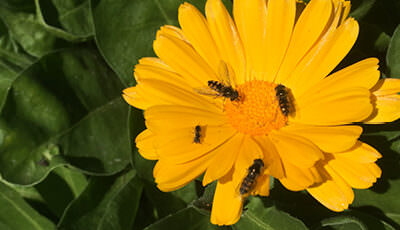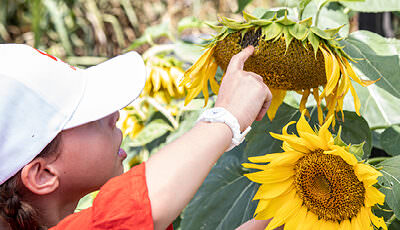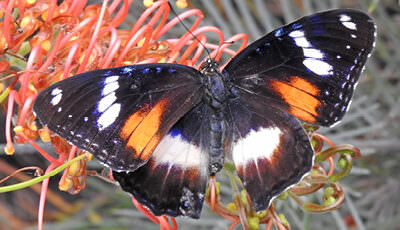
Creating a beneficial garden: investigation
Time Allocation: 30 -40 minutes*
Activity Level: Moderate
Introduction
The aim of this activity is for our young learners to make the connection between beneficial insects in the garden and their relationship to flowering plants. Invertebrates or bugs that provide services such as pollination or pest-predation are commonly known as beneficial insects. These insects can often be encouraged into a garden by planting flowering plants alongside food crops. This is known as beneficial gardening.
*Time allocation will be dependent on site selection and travel time.
Checklist
Instructions
 Step 1
Step 1
Insects and their roles
Role-play insect pollination before heading outside.
Explain that pollination isn’t the only beneficial role that insects perform. Sometimes, insects are predators and are beneficial because they eat pest insects. When flowers attract pollinators, they can also attract predators.
We will be focusing on pollinators and predators in this activity.
 Step 2
Step 2
Investigating
Using the tools and knowledge from the assessment activity, head outside.
Instead of studying the entire habitat, focus on the flowering plants.
Find some flowers (a large clump of flowers works best for this).
Practice quiet, still observation for 2 minutes, allowing the insects to go about their normal business whilst you observe.
Using the paint brushes, gently sweep insects into a container for closer observation.
Place a large sheet of white paper or fabric under some flowering plants and gently shake them. Study what falls out.
 Step 3
Step 3
Review
Review your results. Using your chosen field guide from the assessment activity, investigate the animals you have found.
Ask the students to observe the features of their animals and ask if they know what animals could be predators or pollinators.
Take some time to run ‘think-pair-share’, sourcing knowledge from the group. Consult your field guide for more information.
Ask the children: “Have we found any predators or pollinators that we could be a beneficial insect?”
Some common beneficial insects include:
- Bees: (native and European) Pollinators
- Ladybugs: Predators (larvae and adults) and Pollinators (adults)
- Hover flies: Predators (larvae) and Pollinators (adults)
- Mantids: Predators
 Step 4
Step 4
Refine
Ask the children to develop a hypothesis (a smart guess) about why this animal was found amongst the flowers.
Select a beneficial insect and use the activity sheet to begin the beneficial insect investigation. You will be researching their features, benefits, survival needs and lifecycle and behaviours.
Either inside or in the garden, use resources (digital or printed), to research more information on the chosen animal. Complete the activity sheet.
Review the activity sheets and as a group, place the insects that were studied into a Pollinators and Predators Venn Diagram.
Share this Venn Diagram with the rest of your school.
Extension Activity
Know your enemy. Collect some stems from Aphid-affected plants in the garden (common plants that have aphids include Beets, Chard, Roses, Lettuce, Bok Choi and Beans). Put the stems in a vase to raise them inside. Monitor how their population grows and how quickly they reproduce.
Investigate the land management practices of Aboriginal and Torres Strait Islander peoples. How does sustainable management of the environment protect biodiversity?